Laminated Labels Market Size and Share
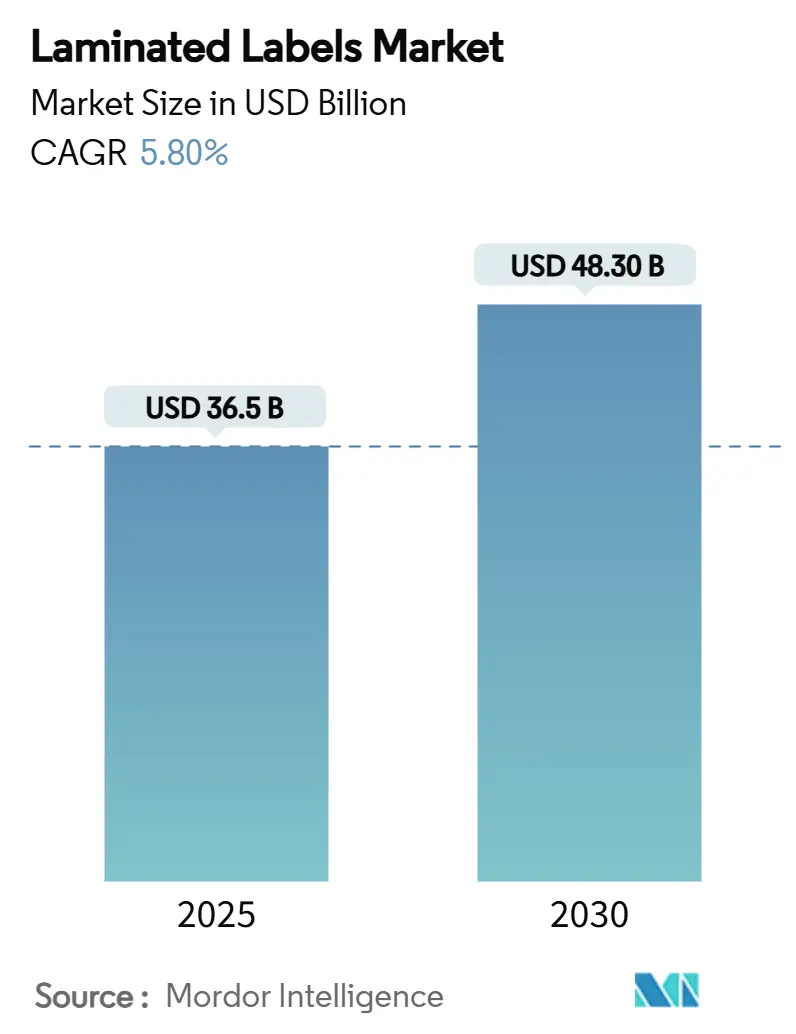
Laminated Labels Market Analysis by Mordor Intelligence
The laminated label market size stood at USD 36.5 billion in 2025 and is forecast to reach USD 48.3 billion by 2030, advancing at a 5.8% CAGR. Rising e-commerce shipping volumes, tougher food‐safety codes, and pharmaceutical serialization mandates are expanding the laminated label market, even as packaging rules tighten around recyclability and carbon disclosures. Demand for durable facestocks that endure automated sortation, together with linerless formats that reduce waste, is widening profit margins for converters that can supply high-performance, regulation-compliant products. Polyester retains the largest material slice, yet polypropylene’s lower cost and printability are lifting its uptake in food and beverage lines. Regionally, Asia-Pacific enjoys scale advantages, while North America is moving fastest on premium, regulation-driven applications.
Key Report Takeaways
- By material type, polyester led with 35.45% laminated label market share in 2024; polypropylene is projected to expand at a 7.48% CAGR to 2030.
- By form, roll labels commanded 58.35% of the laminated label market size in 2024, while sheet labels are set for 6.54% CAGR through 2030.
- By composition, facestocks held 45.45% share of the laminated label market size in 2024; adhesives are advancing at a 7.18% CAGR.
- By printing technology, flexography led with 33.21% revenue share in 2024; ink-jet is the fastest-growing segment at an 8.86% CAGR.
- By end-user industry, food and beverage accounted for 34.87% of the laminated label market in 2024, whereas healthcare is pacing at an 8.01% CAGR.
- By geography, Asia-Pacific controlled 41.34% of the laminated label market in 2024; North America is progressing at an 8.32% CAGR.
Global Laminated Labels Market Trends and Insights
Drivers Impact Analysis
| Driver | (~) % Impact on CAGR Forecast | Geographic Relevance | Impact Timeline |
|---|---|---|---|
| E-commerce boom driving durable shipping labels | +1.2% | Global, concentrated in North America & APAC | Short term (≤ 2 years) |
| Packaged food and beverage demand surge | +1.5% | Global, led by Asia-Pacific | Medium term (2-4 years) |
| Pharmaceutical serialization mandates | +0.9% | North America & EU, expanding to APAC | Long term (≥ 4 years) |
| Linerless laminated labels adoption | +0.7% | Europe & North America early adoption | Medium term (2-4 years) |
| Carbon-footprint disclosure labels | +0.5% | EU primary, North America secondary | Long term (≥ 4 years) |
| Source: Mordor Intelligence | |||
E-commerce boom driving durable shipping labels
Surging online retail volumes have pushed parcel handling intensity up by more than 60%, exposing ordinary labels to temperature swings and mechanical shocks that cause delamination. ASTM D4169-22 now requires sequential hazard testing, prompting converters to engineer substrates that stay bonded to corrugate throughout distribution cycles.[1]International Safe Transit Association, “Process Standards,” ista.org Sustainability goals add a removal-cleanly prerequisite so that labels do not disrupt fiber recycling streams. Linerless rolls such as OptiCut WashOff increase label yield by 50% and slash transport emissions, attracting logistics operators that track Scope 3 footprints. Converters report 15-20% higher margins on e-commerce-specific constructions, while digital print lets shippers embed real-time codes for tracking and returns management.
Packaged food and beverage demand surge
Urban lifestyles and single-serve preferences are lifting packaged food volumes, with India’s packaging spend growing at 26.7% CAGR as brands court rising middle-class consumers.[2] Cosmo Films, “What Is Metalized Film and Its Different Types,” cosmofilms.com India’s FSSAI now bans toluene in food-contact inks, pushing label makers toward low-migration chemistries and rigorous migration testing. Premium snack and beverage lines want metalized pressure-sensitive films that give brighter shelf appeal and barrier protection. Paper-based laminates from partnerships such as Saica-Mondelez target a 25% virgin-plastic cutback without losing heat-sealability. Regional supply diversification, especially within Asia-Pacific, is mitigating disruption risks and stimulating new local capacity additions.
Pharmaceutical serialization mandates
The Drug Supply Chain Security Act obliges U.S. prescription packs to carry unique numerical identifiers plus scannable barcodes under 21 CFR 201.25.[3]Food and Drug Administration, “21 CFR 201.25 — Bar Code Label Requirements,” ecfr.gov Europe’s parallel device-identification rules further require tamper-evident features, boosting demand for high-security laminated formats. Serial coding accuracy has elevated digital ink-jet adoption because variable data must print at production speed without smearing. Sustainability adds another layer: drug firms now favor recyclable facestocks that still accept covert inks and holographic foils. Global adoption of GS1 standards is steering multinational pharma toward suppliers that hold international regulatory know-how and multi-plant redundancy.
Linerless laminated labels adoption
Waste-reduction mandates in Europe and North America are accelerating linerless uptake. Avery Dennison’s AD LinrSave yields as many as 80% more labels per roll and trims CO₂ by 30%. Foodservice operators value the lower roll-change frequency, while parcel hubs appreciate the lighter cores that cut shipping costs. Production, however, needs precise silicone and adhesive lay-downs to stop printer jam-ups, and legacy print-and-apply lines often require retrofits. Equipment specialists now market purpose-built applicators to handle tension and feed alignment. Brands with corporate zero-waste pledges willingly pay premiums for the reduced environmental footprint.
Restraints Impact Analysis
| Restraint | (~) % Impact on CAGR Forecast | Geographic Relevance | Impact Timeline |
|---|---|---|---|
| Raw-material price volatility | -1.8% | Global, acute in petrochemical-dependent regions | Short term (≤ 2 years) |
| Shift to metallized foils and shrink sleeves | -0.9% | North America and Europe premium segments | Medium term (2-4 years) |
| Solvent-borne ink and adhesive regulation | -0.7% | North America and EU primary, expanding globally | Medium term (2-4 years) |
| Closed-loop paper packs eliminating plastic labels | -0.4% | Europe primary, North America secondary | Long term (≥ 4 years) |
| Source: Mordor Intelligence | |||
Raw-material price volatility
Propylene feedstock is forecast to top 40 cents/lb by mid-2025 following refinery rationalizations, raising polyester and polypropylene film costs. December 2024 contracts already traded at 35.75 cents, telegraphing lasting inflation into 2026. Brady Corporation disclosed raw-material spikes as a chief drag on FY 2024 margins. Converters are exploring recycled or bio-based resins, yet volumes remain low and premiums high. Multi-supplier strategies and regional inventory buffers are becoming standard risk-management playbooks.
Shift to metallized foils and shrink sleeves
Premium beverage and personal-care brands are migrating from traditional laminated labels toward 360-degree shrink sleeves that contour complex bottles and deliver high-gloss graphics. Shrink films now reach 65% free-shrink at 90 °C while keeping clarity during PET recycling. As economies of scale advance, cost gaps with pressure-sensitives are narrowing, pressuring label volumes in certain high-turn categories. EU recycling targets that prefer mono-material solutions may further tilt packaging buyers toward foils or sleeves that integrate directly into container recovery streams. Digital presses able to print on shrink film strengthen the substitution threat by enabling batch-level customization once unique to labels.
Segment Analysis
By Material Type: Polyester pre-eminent yet polypropylene rising
Polyester delivered the largest slice of the laminated label market at 35.45% in 2024 thanks to chemical resistance vital for pharma, chemical drum, and outdoor-exposure uses. Polypropylene’s 7.48% CAGR through 2030 reflects food and beverage converters embracing its lower density, higher yield, and smoother print surface. EU rules dictating 30% recycled PET in packaging by 2030 are pushing buyers to recycled PET facestocks, though supply lags demand and prices remain elevated. Vinyl continues to decline amid REACH microplastics curbs. Bio-films are a niche today but attract brands pursuing compostable or bio-sourced messaging.
Looking ahead, recycled content mandates should tighten polyester’s availability and buoy prices, possibly accelerating polypropylene’s replacement rate in cost-sensitive SKUs. Simultaneously, R&D around bio-based PET and chemically recycled resins promises future volumes once scale materializes. Suppliers that can qualify recycled inputs without sacrificing clarity or stiffness will seize share as the laminated label market rewards low-carbon footprints.
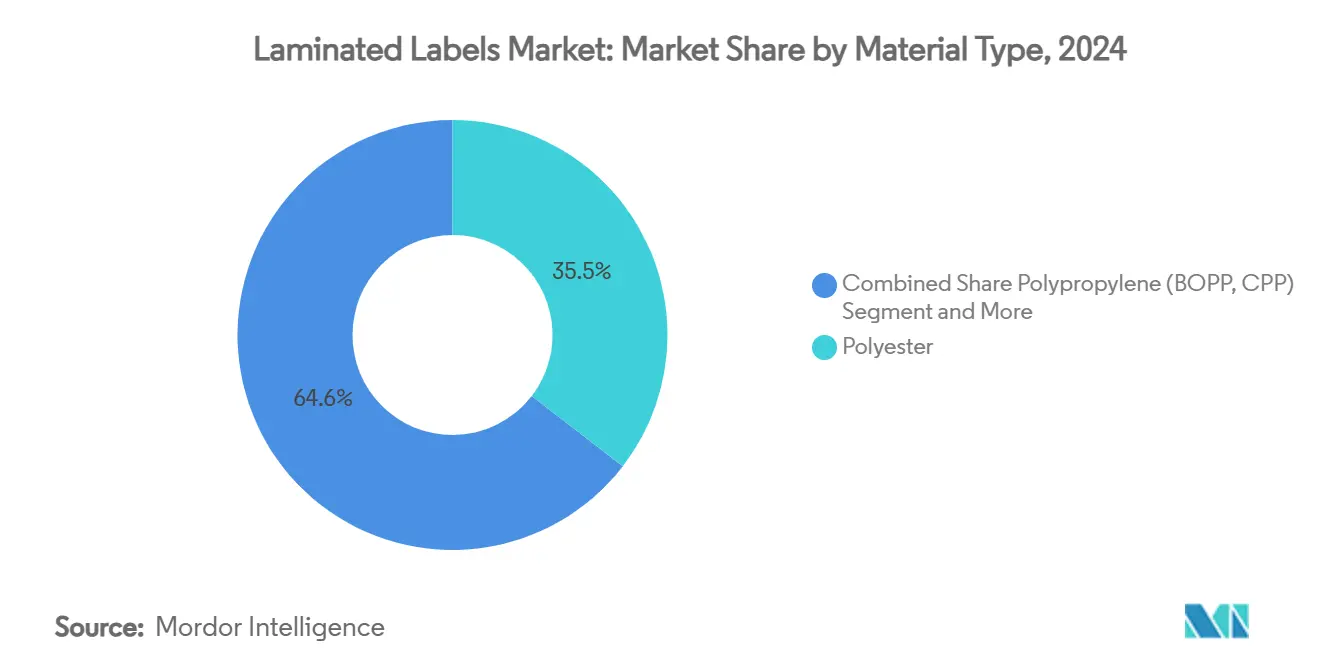
Note: Segment shares of all individual segments available upon report purchase
By Form: Rolls keep speed edge while sheets cater to customization
Roll configurations dominated 58.35% of laminated label market share in 2024 because automated applicators in beverages, pharmaceuticals, and logistics depend on continuous web feeds. Sheet labels, though only 41.65%, clock a 6.54% CAGR on the back of digital presses that handle short runs for craft food, cosmetics, and seasonal campaigns. Automatic splicing systems like Unisplice 413 raised line uptime by 10%, reinforcing rolls’ productivity advantage.
Sheets, however, let brand owners vary artwork across multiple SKUs without tooling, cutting inventory waste. As e-commerce microbrands proliferate, sheet demand will intensify for orders under 1,000 units where flexo setup costs are untenable. Linerless technology reinforces rolls’ appeal, yet printer retrofits required for butt-cut webs may limit adoption to large fleet owners initially.
By Composition: Facestocks lead, adhesives innovate fastest
Facestock layers accounted for 45.45% of laminated label market revenue in 2024 because substrate choice governs durability, print fidelity, and aesthetics. Adhesives, while a smaller base, are accelerating at 7.18% CAGR as water-borne, UV, and solvent-free chemistries replace N-Methylpyrrolidone formulas now under EPA scrutiny. Release-liner redesigns aim at recyclability, with FINAT’s goal of 75% liner recovery by 2025 spurring interest in glassine take-back schemes.
Growth in adhesives derives from specialty grades: removable systems for reuse loops, high-heat variants for automotive, and wash-off versions that separate cleanly in PET float-sink tanks. Integrated product bundles are emerging where converters co-optimize facestock, adhesive, and liner for a given end use, locking in customer loyalty and margin.
By Printing Technology: Flexo dominates but digital races ahead
Flexographic presses preserved 33.21% laminated label market share in 2024 as beverage, personal-care, and logistics lines rely on high-speed, low-unit-cost output. Ink-jet systems are outgrowing all rivals at 8.86% CAGR because variable data, SKU proliferation, and just-in-time fulfillment favor tool-less changeovers. Electrophotography keeps a foothold where toner opacity and color precision justify cost, such as wine and cosmetics.
Hybrid lines marrying flexo decks with digital bars are scaling because brand owners need spot varnish and metallics alongside serialized codes. Gravure and offset retreat in medium runs where digital breakevens now sit around 5,000 linear meters. Screen printing clings to niche security and tactile-varnish jobs that ink-jet cannot yet replicate at speed.
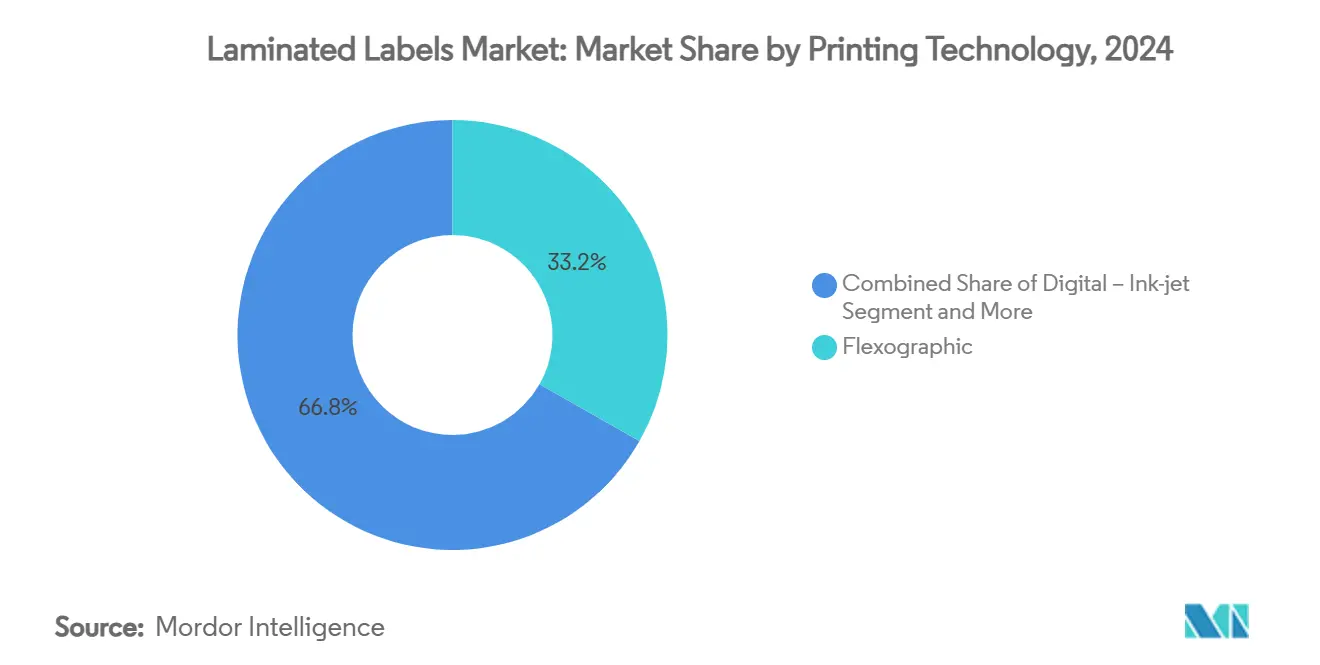
Note: Segment shares of all individual segments available upon report purchase
By End-User Industry: Food rules, healthcare accelerates
Food and beverage captured 34.87% of the laminated label market in 2024, propelled by ingredient transparency laws and export traceability requirements. Saica-Mondelez’s paper transformation underscores how brands pair sustainability with shelf life. Pharmaceuticals post the quickest 8.01% CAGR as DSCSA and EU FMD serialization timelines demand tamper-proof, high-resolution codes. Industrial and electronics labels rely on chemical and heat endurance, while personal care adopts premium foils for brand impact. Logistics labels benefit directly from e-commerce throughput. Over the forecast, healthcare’s security premium plus expanding biologics pipelines make it the pivotal growth lever, but food remains volume anchor.
Geography Analysis
Asia-Pacific held 41.34% of the laminated label market in 2024, buoyed by China’s 6% industrial output rise and 12.7% jump in chemical manufacturing that secures film feedstocks. India’s production-linked incentives aim for 25% GDP contribution from advanced manufacturing by 2025, enlarging domestic demand and export capacity. Multinationals such as Amcor added Gujarat capacity to serve regional snack and personal-care brands, confirming the region’s scale and cost edge. Japan and South Korea contribute high-precision coating know-how, whereas Southeast Asia gains from supply-chain diversification.
North America, projected at an 8.32% CAGR, is propelled by DSCSA serialization, EPA solvent regulations, and rapid parcel-shipping growth. ASTM shipping standards and consumer preference for premium graphics position the region for value-added volumes. Mexico’s role in near-shoring strengthens, illustrated by ProMach’s Etiflex acquisition that expands RFID and variable-data offerings.
Europe maintains regulatory leadership through the Packaging and Packaging Waste Regulation, obliging full recyclability by 2028 and recycled-content thresholds that reshape material menus. FINAT’s liner recycling drive and Germany’s plant-based-ink transition underscore sustainability as the prime competitive lever. Eastern Europe may attract new coating lines as Western converters seek low-cost yet EU-compliant production bases.
Middle East & Africa and South America together form a smaller slice of the laminated label market but register brisk uptake as food-processing and agro-exporters adopt traceability stickers. Infrastructure gaps and currency swings restrain scale for now, though localized manufacturing might rise as governments court investment to cut import dependence.
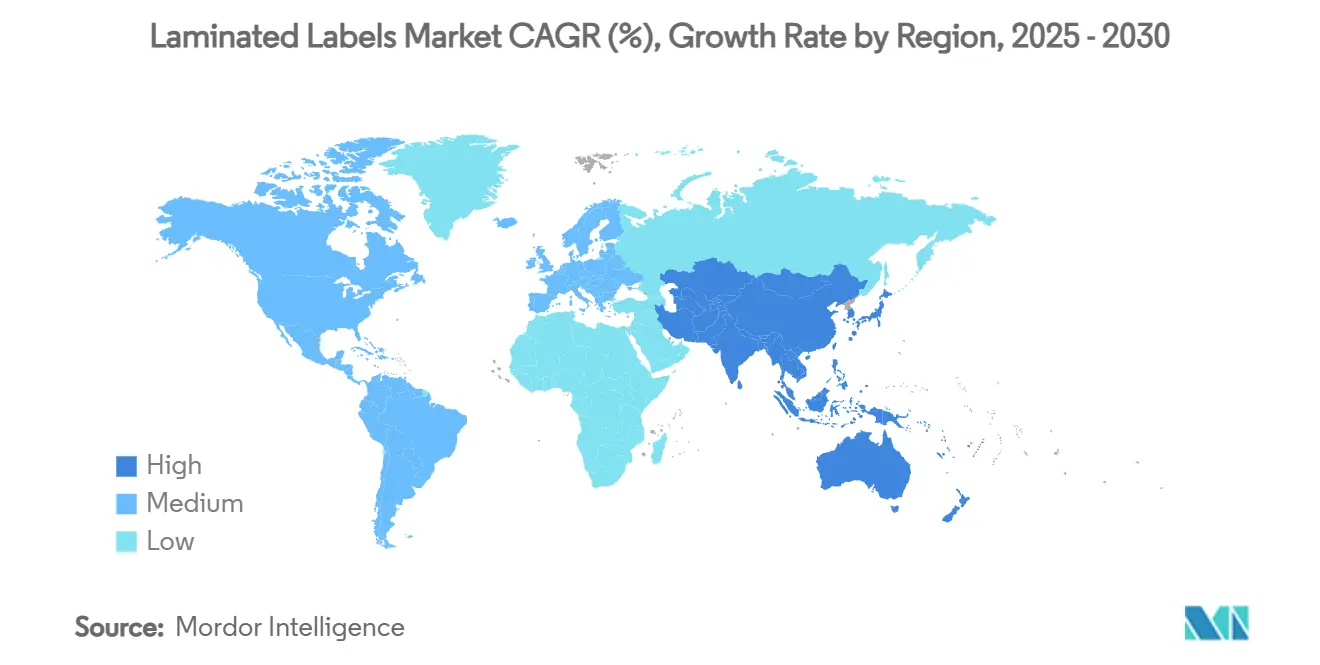
Competitive Landscape
The laminated label market exhibits fragmentation. Avery Dennison posted USD 8.8 billion revenue in 2024 and pushes linerless innovation that cuts CO₂ 30% and water 40%. CCL Industries generated USD 7.245 billion and deepened RFID and specialty film positions through bolt-ons. UPM Raflatac led carbon-footprint disclosure, embedding product LCA data in quotations.
Acquisition momentum signals consolidation: TOPPAN agreed to pay USD 1.8 billion for Sonoco’s thermoformed and flexible unit, expanding into integrated packs. Private-equity owner One Rock closed Constantia Flexibles to build a global platform in films and laminates. Technology entrants focus on hybrid presses and intelligent labels; legacy players answer by licensing patents or forming joint ventures to defend share.
White-space arenas include carbon disclosure labels, security overlays for biologics, and liner-free shipping solutions. Patent filings around covert taggants and high-speed ink deliver proof of sustained R&D. Regional specialists thrive by customizing adhesives for local climates or navigating country-specific food-contact rules. Overall, competition hinges on sustainability credentials, digital capability, and global service coverage.
Laminated Labels Industry Leaders
-
Avery Dennison Corporation
-
Coveris Holdings S.A.
-
CCL Industries Inc.
-
Constantia Flexibles Group GmbH
-
3M Company
- *Disclaimer: Major Players sorted in no particular order
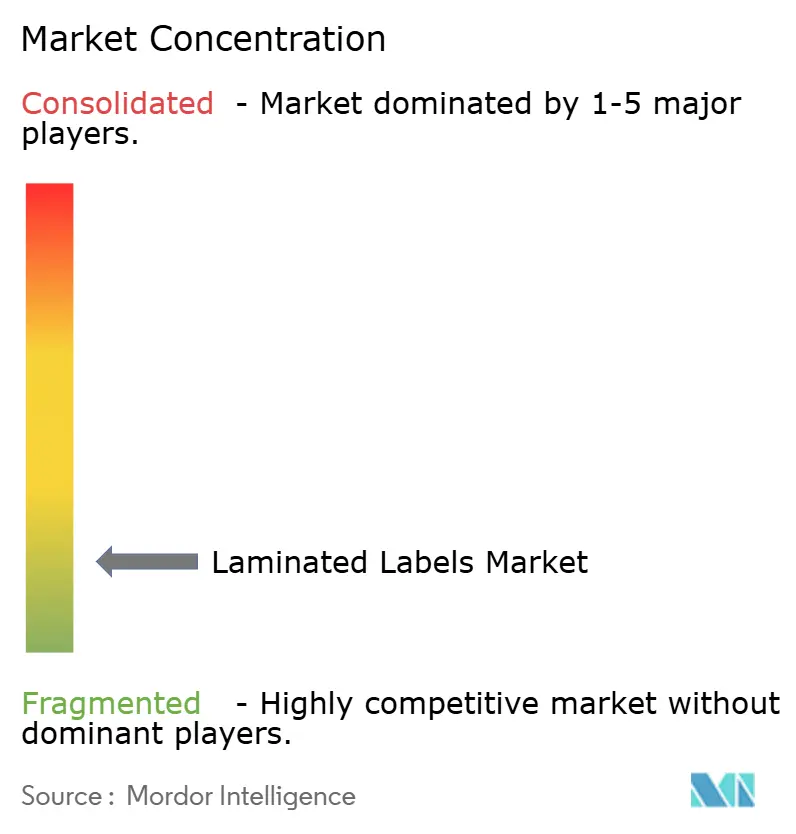


Recent Industry Developments
- June 2025: SATO Group switched printer packaging from foam to cardboard, cutting CO₂ 39% per unit and eliminating 8,596 kg plastic annually.
- April 2025: UPM Raflatac started quoting product carbon footprints, boosting procurement transparency .
- March 2025: ProMach’s ID Technology bought Etiflex, widening North American RFID and pressure-sensitive capacity.
- January 2025: Faller Packaging secured land in Gebesee for a new folding-carton and leaflet plant serving pharma growth.
- October 2024: UPM Raflatac launched OptiCut WashOff linerless technology for reusable plastic packs.
Global Laminated Labels Market Report Scope
Laminated Labels are utilized to seal the base label optimally to give protection against mechanical stress, weathering, and chemical influences. The principal purpose is to give strong protection through multiple layers of composite elements in a laminate. Various films are available that can enhance the appearance as aspired with optical design effects.
| Polyester |
| Polypropylene (BOPP, CPP) |
| Vinyl |
| Biodegradable Films |
| Other Material Type |
| Rolls |
| Sheets |
| Facestock |
| Adhesive |
| Release Liner |
| Flexographic |
| Digital - Ink-jet |
| Digital - Electrophotography |
| Gravure |
| Offset |
| Screen / Letterpress |
| Food and Beverage |
| Manufacturing and Industrial |
| Electronics and Appliances |
| Pharmaceuticals and Healthcare |
| Personal Care and Cosmetics |
| Retail and Logistics |
| Other End-user Industry |
| North America | United States | |
| Canada | ||
| Mexico | ||
| Europe | Germany | |
| France | ||
| Italy | ||
| Spain | ||
| United Kingdom | ||
| Russia | ||
| Rest of Europe | ||
| Asia-Pacific | China | |
| India | ||
| Japan | ||
| South Korea | ||
| Australia | ||
| Rest of Asia-Pacific | ||
| Middle East and Africa | Middle East | Saudi Arabia |
| United Arab Emirates | ||
| Turkey | ||
| Rest of Middle East | ||
| Africa | South Africa | |
| Nigeria | ||
| Rest of Africa | ||
| South America | Brazil | |
| Argentina | ||
| Rest of South America | ||
| By Material Type | Polyester | ||
| Polypropylene (BOPP, CPP) | |||
| Vinyl | |||
| Biodegradable Films | |||
| Other Material Type | |||
| By Form | Rolls | ||
| Sheets | |||
| By Composition | Facestock | ||
| Adhesive | |||
| Release Liner | |||
| By Printing Technology | Flexographic | ||
| Digital - Ink-jet | |||
| Digital - Electrophotography | |||
| Gravure | |||
| Offset | |||
| Screen / Letterpress | |||
| By End-user Industry | Food and Beverage | ||
| Manufacturing and Industrial | |||
| Electronics and Appliances | |||
| Pharmaceuticals and Healthcare | |||
| Personal Care and Cosmetics | |||
| Retail and Logistics | |||
| Other End-user Industry | |||
| By Geography | North America | United States | |
| Canada | |||
| Mexico | |||
| Europe | Germany | ||
| France | |||
| Italy | |||
| Spain | |||
| United Kingdom | |||
| Russia | |||
| Rest of Europe | |||
| Asia-Pacific | China | ||
| India | |||
| Japan | |||
| South Korea | |||
| Australia | |||
| Rest of Asia-Pacific | |||
| Middle East and Africa | Middle East | Saudi Arabia | |
| United Arab Emirates | |||
| Turkey | |||
| Rest of Middle East | |||
| Africa | South Africa | ||
| Nigeria | |||
| Rest of Africa | |||
| South America | Brazil | ||
| Argentina | |||
| Rest of South America | |||


Key Questions Answered in the Report
What is the current size of the laminated label market?
The laminated label market size reached USD 36.5 billion in 2025 and is projected to climb to USD 48.3 billion by 2030.
Which region is growing fastest in the laminated label market?
North America shows the highest growth, registering an 8.32% CAGR to 2030 due to stringent serialization laws and premium packaging demand.
Why are linerless laminated labels gaining traction?
They provide up to 80% more labels per roll, lower CO₂ emissions about 30%, and cut disposal costs, making them attractive for logistics and foodservice users.
What material is most used in laminated labels today?
Polyester leads with 35.45% market share because of its chemical resistance and dimensional stability.
Page last updated on:








